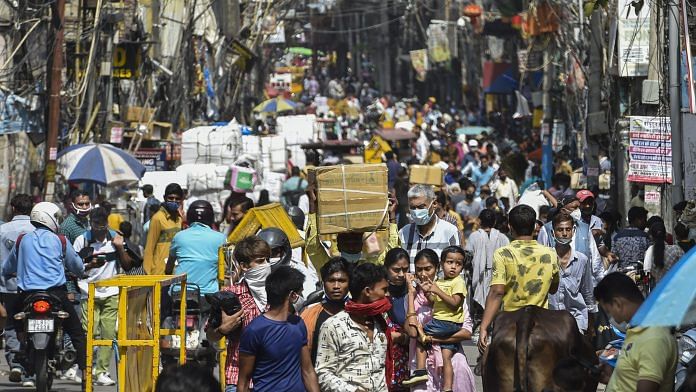Just weeks after China amended its two-child policy, India’s most populous state Uttar Pradesh is looking at a carrot-and-stick experiment with its proposed two-child policy. In the election season, it is bound to be seen through political lens and there are already concerns about the negative impact it can have on sex ratio. But 46 years after the Emergency, India cannot afford to have an if-and-but approach to population control.
The draft Uttar Pradesh Population (Control, Stabilisation and Welfare) Bill 2021 introduced by chief minister Yogi Adityanath has reignited a debate that has, on and off, occupied the minds of politicians and policymakers for decades. And that is why India’s population, its control and the impact it has on the country’s socio-economic prosperity is ThePrint’s Newsmaker of the Week.
While Uttar Pradesh’s proposed law, given the imminence of crucial assembly election in that state, has created the most political heat, it is by no means the only state walking the path. Assam too has announced a similar law, Rajasthan has flirted with such legislation and Maharashtra, Odisha, Madhya Pradesh, Telangana and Andhra Pradesh also debar people with over two children from contesting zilla parishad elections.
Also read: Population control through State action never worked in India. Time to focus on economy
Population burden…
India is among the worst Covid-19 hit nations, has the highest burden of tuberculosis, and its annual birth cohort of 2.64 crore babies also tops the world. The famed demographic dividend is not yet fully apparent but the negatives of a burgeoning population in a resource constrained country have been on full display for some decades now.
Contrary to popular perception, family size is not a function of religion, it is a function of socio-economic status. Poorer people tend to have more babies and educational qualifications, particularly of the mother, have been found to be directly linked to the number of children a family has. The worst sufferers of this population explosion have been Uttar Pradesh and Bihar; they are also the states that have traditionally been blamed for pulling down India’s human development indices. At 2.2, the total fertility rate in India (which is the average number of children a woman of reproductive age will have in her lifetime) is just marginally above the replacement fertility rate of 2.1. Replacement fertility means the population is just replaced and neither goes up nor down. Anything lower signals a population that is reducing in size.
In Uttar Pradesh, the TFR, as per National Family Health Survey 4, is 2.7 and in Bihar it is 3.4. Admittedly, it is also a fact that UP has gone down from 3.8 in NFHS 3 (2005-06) and Bihar has improved from 4 in the same edition of the survey. But there is also no doubt that population control needs to be a priority in Uttar Pradesh if the state is to shed its BIMARU tag.
Also read: CM Yogi’s UP population control bill is designed to serve only one purpose — 2022 election
…and the politics around it
Population control is a political minefield, as Uttar Pradesh chief minister finds it, in response to his latest policy. He is not alone. Over the years, many states have toyed with and rejected the idea of a legal provision to restrict family size. Even the government of India’s own choice of words — family planning rather than population control — is the legacy of Sanjay Gandhi and his infamous experiment of forced male sterilisation during the Emergency. Salman Rushdie paints a graphic picture of those times in Midnight’s Children.
But beyond history and literature, the association has been such that any mention of Sanjay Gandhi and population in the same breath sends Congress governments scurrying for cover. In 2010, during a debate in the Lok Sabha, when JD(U) leader Sharad Yadav called for stringent population control measures invoking Gandhi, then health minister Ghulam Nabi Azad, one time associate of the late leader, immediately stood up to make the point that the government’s methods since then had changed drastically.
The other lasting legacy of Sanjay Gandhi on the family planning programme is the overwhelming focus on female sterilisation. According to the NFHS 4, at over 36 per cent, female sterilisations are the most practised method of family planning and at 0.3 per cent, male sterilisations are the least preferred. Myths about men losing their “power” post-sterilisation that could impact their ability to do menial labour have persisted. Even though, officially, India stopped setting family planning targets, the riskier female sterilisation continues. In 2014, 12 women died in Chhattisgarh following tubectomies (female sterilisation operation) in a government-run camp.
There are many reasons that practitioners give for large family size — from son preference to having more hands for higher family income. But it has been widely recognised for some time now that the need of the hour is to incentivise smaller families and penalise large ones.
That is why the UP population Bill, which proposes a two-child norm and bars violators from contesting the local body polls, promotions in government jobs, and receiving any kind of government subsidy, may be a step in the right direction. In fact, it is the logical next step towards what many governments have already done to address son preference — think West Bengal’s Kanyashree and Delhi’s Ladli Scheme.
It is an idea whose time has come but an election year may not be the best time to start.
Views are personal.
(Edited by Anurag Chaubey)



